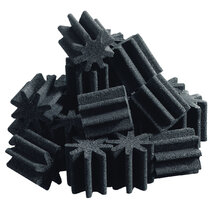Hi all,
I could never understand why they were so expensive to buy for what was essentially a piece of plastic.........
I've got some of those as well.
That is it really the heart of it. A star shaped piece of plastic that will have <"
cost pennies to manufacture">, but carefully dressed up with clever marketing,
<"shape and name"> to imply that you are getting something unique and special at a premium price.
one with “an internal network of 50 to 70 µm pores”
It is <"
classic diversionary tactics">, make all the conversation about something that is <"
totally irrelevant">.
Seemed to work though, so I guess it supports the theory that biological filtration will take place on any surface to which the bacteria can attach.
Pretty much, a biofilm will develop and that <"
will contain the micro-organisms that perform nitrification"> As soon as you know that a lot of biological filtration systems, in <"
waste water treatment"> and <"
aquaculture">, don't have any static media, just "bioflocs", it tells you that static media isn't that important.
Some non-essential conjecture.
First the bit <"
we know">, that the nature of that <"
microbial assemblage"> is <"
fine-tuned over time"> to reflect the levels of ammonia (NH3) and dissolved oxygen in the water.
This would be conjecture, but I visualise the microbial assemblage in a filter in the same way that I think about the <"
benthic invertebrate assemblage in a stream">. In clean water (water with a lot of dissolved oxygen and a low Biochemical Oxygen Demand (BOD)) you have a diverse assemblage of invertebrates, including <"
Mayflies (Ephemeroptera), Stoneflies (Plecoptera), Caseless Caddis (Trichoptera) etc."> with Tubificid worms (Naididae) and "Bloodworms" (Chronomidae) etc present, but as a minor component of the assemblage.
As pollution (BOD) increases dissolved oxygen levels fall and you lose the more sensitive species from the assemblage. At the same time the number of Blood worm and "Tubifex" increases. As pollution continues to increase eventually only the haemoglobin containing Blood worms and Tubifex are left, and these often <"
build up to huge numbers">.
The "Tubifex and Blood-worm" scenario is the traditional view of "cycling", with
Nitrobacter winogradskyi etc representing Tubifex etc. If you only ever look at sewage treatment works? You never find the Mayflies.
cheers Darrel








